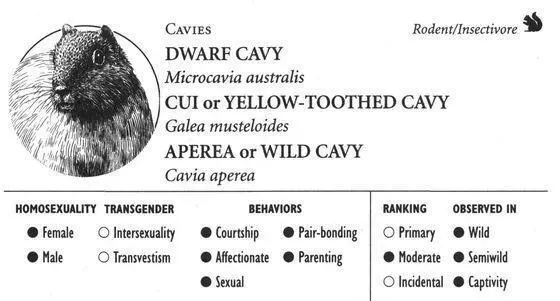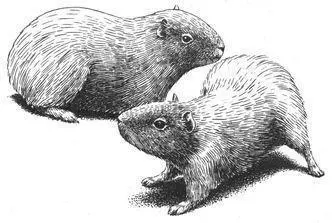Sources
*asterisked references discuss homosexuality/transgender
*Barash, D. P. (1989) Marmots: Social Behavior and Ecology. Stanford: Stanford University Press.
———(1981) “Mate Guarding and Gallivanting by Male Hoary Marmots ( Marmota caligata ) .” Behavioral Ecology and Sociobiology 9:187–93.
*———(1974) “The Social Behavior of the Hoary Marmot ( Marmota caligata ) .” Animal Behavior 22:256–61.
*———(1973) “The Social Biology of the Olympic Marmot.” Animal Behavior Monographs 6:171–245.
Holmes, W. G. (1984) “The Ecological Basis of Monogamy in Alaskan Hoary Marmots.” In J. O. Murie and G. R. Michener, eds., The Biology of Ground-Dwelling Squirrels: Annual Cycles, Behavioral Ecology, and Sociality, pp. 250–74. Lincoln: University of Nebraska Press.
Wasser, S. K., and D. P. Barash (1983) “Reproductive Suppression Among Female Mammals: Implications for Biomedicine and Sexual Selection Theory.” Quarterly Review of Biology 58:513–38.

IDENTIFICATION: Small, guinea-pig-like rodents with coarse fur; Dwarf Cavies have a distinctive white eye-ring, Cuis have yellow-colored incisors. DISTRIBUTION: South America, primarily Peru, Bolivia, Argentina, Chile. HABITAT: Savanna, brushlands. STUDY AREAS: Several locations in Buenos Aires Province, Argentina, including near Magdalena, Tornquist, and Carmen de Patagones.
Social Organization
Cavies live in colonies of 20–50 animals, although no permanent social groupings occur. Each female usually has her own home bush under which she lives and raises her young. The mating system is promiscuous, in that males and females copulate with multiple partners without forming any long-lasting heterosexual bonds.
Description
Behavioral Expression: Cavies participate in a wide variety of homosexual courtship patterns, most of which are also found in heterosexual interactions. In Dwarf Cavies, adult males are sexually attracted to juveniles of both sexes. A typical homosexual courtship begins with the adult and the younger male sitting quietly together—often right in front of the youngster’s mother, who is not visibly disturbed. The two males may kiss and nuzzle their noses together, after which the adult begins to gently nibble on the juvenile’s rump. This is often followed by a courtship behavior known as CHIN-RUMP FOLLOWING, in which the adult male places his chin on the youngster’s rump, as they move together in circles or figure-eight patterns. If the male is especially aroused, he will stop to pat his paws against the juvenile’s rump, sometimes even licking, sniffing, and nuzzling the anus and perineal region while lifting up the youngster’s hindquarters with his nose. Adult males frequently have favorite males that they prefer to court and interact sexually with, actively seeking them out while ignoring others.
Female Cuis (and less commonly, males) use a stylized form of same-sex courtship chasing known as REARING: one female approaches another and rears up on her hind legs as if to mount, then drops back down on all fours to follow the other female, repeating the pattern. Sometimes this leads to actual mounting, in which one female thrusts against the other in an upright posture behind her. Homosexual mounting is common when females are in heat, but it also occurs when a female is not in heat and even when she is pregnant. Among Apereas, females court one another by performing the RUMBA: in this courtship dance, one female rhythmically sways her hindquarters from side to side while slowly approaching, circling, or following another female. She may also make a burbling sound known as RUMBLING. Adult male Apereas sometimes court younger males by RUMPING, in which the adult throws one or both hind legs over the rump of the youngster.
A female Aperea ( right ) performing a “rumba” while courting another female

Dwarf Cavies also sometimes bond with animals of the same sex, forming “companionships” and even coparenting arrangements. Two (occasionally three) females share a home (living under the same bush), frequently sitting together and kissing each other with prolonged nuzzling of mouths and noses. They may even cooperate in nursing one another’s young. Adult males occasionally also have an adolescent companion; the two males sit and feed together, as well as kiss one another. Sometimes the adult male will permit his companion to mount a female that he is courting.
Frequency: Homosexual courtships make up 58 percent of adult-juvenile chin-rump follows (and 44 percent of all such courtships) in Dwarf Cavies, while more than a third of Cui courtship rearing interactions are between females. Homosexual courtships are less common in Apereas.
Orientation: Most Cavies that participate in same-sex activities are probably bisexual. For example, adult male Apereas and Dwarf Cavies court both juvenile males and females, while same-sex bonded Dwarf Cavies usually copulate with members of the opposite sex. However, there are differences in the apparent preference of adult males for homosexual interactions: in Dwarf Cavies, the majority of adult-juvenile courtships are homosexual, while in Apereas fewer such courtships are same-sex.
Nonreproductive and Alternative Heterosexualities
Cavies regularly engage in heterosexual courtship and sexual behaviors that are nonprocreative. Female Cuis that are pregnant, lactating, or not in heat, for example, often participate in mounting and courtship (including REVERSE mounting of males). Aperea males commonly court pregnant females. Male Dwarf Cavies occasionally masturbate by sitting back on their haunches, making pelvic thrusts, and then licking and nuzzling the erect penis. As mentioned above, sexual behavior between adults and juveniles is widespread in these species. About a quarter of all courtship and sexual interactions in Dwarf Cavies involve adult males and juveniles, while adult male Cuis also chin-rump follow juvenile females as young as two weeks old. In addition, juvenile Cuis of both sexes sometimes mount both adult males and females, including their own mothers. Cui mothers have also developed an extensive system of communal nursing in which most females suckle young other than their own. Although each female nurses her own offspring for longer periods than she does others’, she may actually spend a greater total amount of time nursing nonoffspring.
Other Species
Homosexual behavior occurs in several other rodents. Adult males in two other species of Cavies, the Mocó or Rock Cavy ( Kerodon rupestris ) and the Prea ( Galea spixii ) , also sometimes court juvenile males, and youngsters mount adults of both sexes as well. Male Spinifex Hopping Mice ( Notomys alexis ) from Australia sometimes engage in sexual and bonding activities with one another, including mounting, nesting together, feeding and resting beside each other, and burrowing in tandem. Both male and female Brown Rats ( Rattus norvegicus, the wild ancestor of the common household and laboratory rat) participate in homosexual mounting. Male Eastern Cottontail Rabbits (Sylvilagus floridanus) sometimes court other males in addition to females, including displays such as the JUMP SEQUENCE, in which the two males alternately rush toward and jump over one another. Males in this species also occasionally attempt to mount other males. In some populations of Kangaroo Rats (Dipodomys ordii), as many as 16 percent of the animals are intersexed, having the reproductive organs of both sexes (including a vagina, penis, uterus, and testes).
Читать дальше














